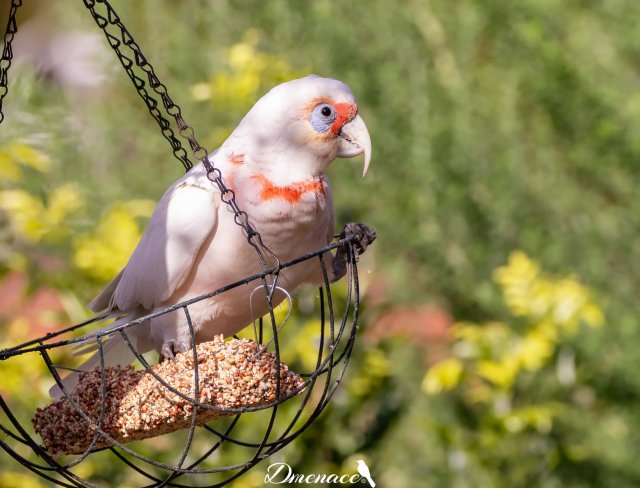Hi people, it's been a while since I've posted. I had to relocate and haven't had many opportunities to get out and about with the camera in the past 12 months.
I caught this guy making the most of a friends garden feeder during a brief sunny break on a cold, wet, windy winter afternoon in Melbourne.











Such a fine shot of such a fine bird & such a pity that people feel compelled to artifically feed birds rather than provide &/or protect their natural habitats.
I tend to agree, Woko, but are those who would say that the jury is still out on the matter. This Brisbane based Professor of Ecology certainly disagrees, provided that the appropriate protocols are applied.
http://www.abc.net.au/news/2018-02-05/this-ecologist-will-make-you-feel-better-about-feeding-birds/9383686
Thanks Dmenace.
I've read the professor's stuff. I still can't see value in artificialy feeding birds when there's plenty of evidence that protecting & providing habitat has so many benefits. Why spend time keeping feeding stations clean (& there's no guarantee of cleanliness) when that time could be used on habitat which will "benefit" not just birds at bird feeders but a range of other native creatures which contribute to biodiversity - especially when we know that our biodiversity is being wrecked at a fast clip? Seems a no-brainer to me. The only real benefit that I can see in bird feeding stations is that they might be stepping stones to motivate some folk to learn more about birds & their habitat needs & then to act accordingly. It would be interesting to know if there is any research to show there is this sort of connection.
The debate continues.
The debate does continue, Woko. But I agree with you, it's all about the environment. I grew up in the NT in the 60s/70s and spent a lot of time in the bush with my aboriginal mates, that's how I developed my love of nature, especially birds.
I worked up at Yulara, the Uluru resort, a few years back and the place is a mecca for birds, simply because of the huge number of Australian native ornamental plants that had been put in as a showcase for overseas tourists. The birds outnumbered the bloody rabbits, and the abundance of prey species attracted the the raptors. Every now and then the crested pidgeons would scatter, and when you looked up there was a grey falcon on patrol. There was even a resident pair of wedged-tailed eagles nearby.
You could argue that it's still a manmade environment, but the birds were feeding naturally.
There is some merit in the professors comments but he is naive on much of it. This goes back a lot deeper than we think. It probably started as a blanket staement to stop people feeding the birds because they were giving the birds the wrong food ie bicuits and other processed food. A classic example of this is I saw a young family letting the rug rats feed raindbow lorikeets HOT potato chips, they were blowing on the chip as they gave it to the bird.
Bird seed in the shops is treated to kill weavils etc. whereas the same seed taken in the field would be safe as it has not been harvested. Caged parrots are fed high fat diets by giving them to much sunflower seed. They don't need that high energy diet unless they are in the wild and have to fly long distances for the next meal. It is like you or me eating a diet of Big Macs and not exercising.
The statement on birds may die if you were to stop feeding them. What a load of BS. Birds do have wings and they do have a seasonal "food trail they follow and if one feeds the birds then that is only added to the birds food trail. In Canada and the USA they feed the humming birds suet because they say the fat is a rich source of sugars when digested. Hmmmm.
Personally I believe people should plant the relevant trees/shrubs to attract the birds to their gardens and supply fresh water in a secure place away from any predator attacks.
We have a resident flock of double barred finches that are not fed. Also a resident flock of superb fairy wrens and they are not fed. Why are they resident when I don't feed them? Simple they have a constant supply of fresh water to drink and bathe and it is made to keep the larger birds eg. rainbow loris, cockatoos, corellas, magpies etc out by planting appropriate shrubs and siting the three baths inside the shrubery. The are a good selection of local eucalypts, callistomens and paperbarks so that there is always something in flower all the time.
Well we could go on and on on this
And we probably will, dougt, because there are still many folk out there who want to attract birds for their own delight rather than to protect & restore biodiversity on which we, including non-human species, all depend. The importing of Australian ornamental plants to Uluru, as mentioned by Dmenace, rather than relying on the natural vegetation that's already there is a classic case in point. I can imagine many tourists returning to their local nurseries to buy up big on Australian ornamentals in the hope of attracting the birds they saw at Uluru!
Your point about not needing to artificially feed birds to attract them is well made. Provide the natural habitat & they will come, the moreso if the local council & neighbours are keen on ecological restoration rather than planting any old junk species.
I've been to a couple of presentations by Darryl Jones and bought his book on the tpic (though not yet read it). He does make a few interesting points.
I don't think he is strictly advocating for bird feeding.
Some of his key points:
Cheers
Tim
Brisbane